机器学习中的优化算法综述
机器学习算法与模型的优化与改进
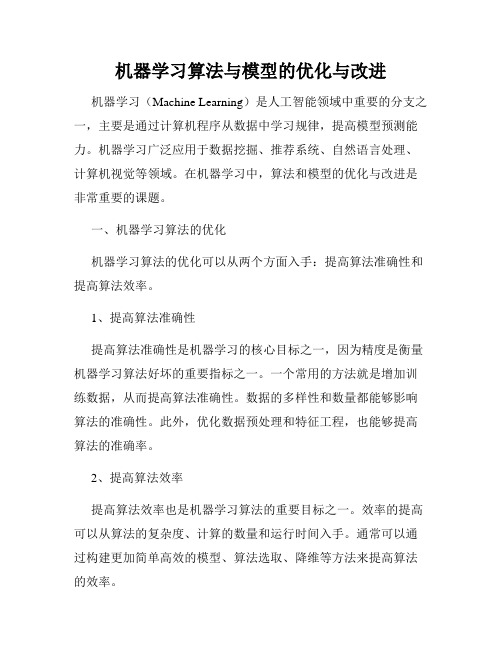
机器学习算法与模型的优化与改进机器学习(Machine Learning)是人工智能领域中重要的分支之一,主要是通过计算机程序从数据中学习规律,提高模型预测能力。
机器学习广泛应用于数据挖掘、推荐系统、自然语言处理、计算机视觉等领域。
在机器学习中,算法和模型的优化与改进是非常重要的课题。
一、机器学习算法的优化机器学习算法的优化可以从两个方面入手:提高算法准确性和提高算法效率。
1、提高算法准确性提高算法准确性是机器学习的核心目标之一,因为精度是衡量机器学习算法好坏的重要指标之一。
一个常用的方法就是增加训练数据,从而提高算法准确性。
数据的多样性和数量都能够影响算法的准确性。
此外,优化数据预处理和特征工程,也能够提高算法的准确率。
2、提高算法效率提高算法效率也是机器学习算法的重要目标之一。
效率的提高可以从算法的复杂度、计算的数量和运行时间入手。
通常可以通过构建更加简单高效的模型、算法选取、降维等方法来提高算法的效率。
二、机器学习模型的优化机器学习模型的优化是机器学习团队研究的一个主要课题,优化的目标是提高模型的泛化能力和预测准确率。
1、提高模型泛化能力提高模型泛化能力是机器学习模型优化的重要方向之一。
模型的泛化能力是指模型在处理未知数据时的表现能力,在测试集和生产环境中的表现就是衡量它的泛化能力的重要指标之一。
提高模型泛化能力有以下几方面的方法:(1)数据增强:通过对现有的训练数据进行数据增强的操作,比如旋转、翻转、缩放等,从而扩大数据集,提高泛化能力。
(2)正则化:增强模型的泛化能力,可采用L1正则化,L2正则化等等。
(3)交叉验证:通过划分训练集和测试集,并交叉验证,提高泛化能力。
2、提高模型预测准确率提高模型预测准确率是机器学习模型优化的另一个重要目标。
针对不同的机器学习算法,有不同的优化方法。
(1)神经网络优化:优化神经网络的模型结构,比如增加层数、增加节点等。
这些操作可以增加模型的表达能力,提高预测准确率。
机器学习模型的优化方法
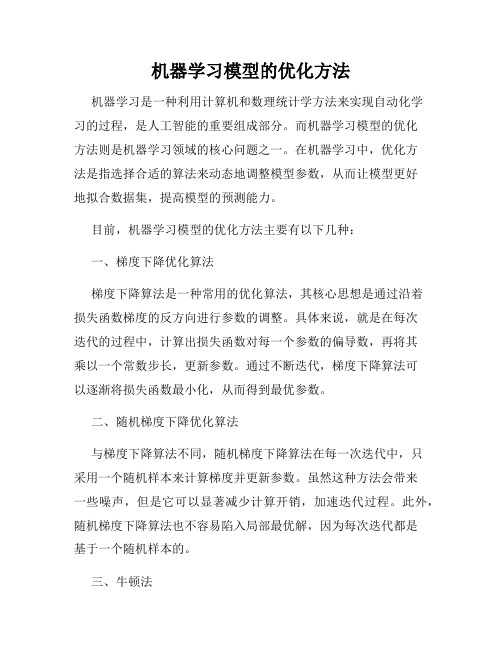
机器学习模型的优化方法机器学习是一种利用计算机和数理统计学方法来实现自动化学习的过程,是人工智能的重要组成部分。
而机器学习模型的优化方法则是机器学习领域的核心问题之一。
在机器学习中,优化方法是指选择合适的算法来动态地调整模型参数,从而让模型更好地拟合数据集,提高模型的预测能力。
目前,机器学习模型的优化方法主要有以下几种:一、梯度下降优化算法梯度下降算法是一种常用的优化算法,其核心思想是通过沿着损失函数梯度的反方向进行参数的调整。
具体来说,就是在每次迭代的过程中,计算出损失函数对每一个参数的偏导数,再将其乘以一个常数步长,更新参数。
通过不断迭代,梯度下降算法可以逐渐将损失函数最小化,从而得到最优参数。
二、随机梯度下降优化算法与梯度下降算法不同,随机梯度下降算法在每一次迭代中,只采用一个随机样本来计算梯度并更新参数。
虽然这种方法会带来一些噪声,但是它可以显著减少计算开销,加速迭代过程。
此外,随机梯度下降算法也不容易陷入局部最优解,因为每次迭代都是基于一个随机样本的。
三、牛顿法牛顿法是一种基于二阶导数信息的优化算法,它可以更快地收敛到局部最优解。
具体来说,就是在每一次迭代过程中,对损失函数进行二阶泰勒展开,将其转化为一个二次方程,并求解其最小值。
虽然牛顿法在求解高维模型时计算开销比较大,但是在处理低维稠密模型时可以大幅提高迭代速度。
四、拟牛顿法拟牛顿法是一种基于梯度信息的优化算法,它通过近似构造损失函数的Hessian矩阵来进行迭代。
具体来说,拟牛顿法在每一次迭代过程中,利用历史参数和梯度信息来逐步构造一个近似的Hessian矩阵,并将其用于下一步的参数更新。
相比于牛顿法,拟牛顿法不需要精确计算Hessian矩阵,因此更适合处理高维稀疏模型。
在实际应用中,根据不同的场景和需求,可以选择不同的优化算法来优化机器学习模型。
需要注意的是,优化算法的选择并非唯一的,需要根据具体情况进行综合考虑。
此外,还可以通过调整迭代步长、设置合适的正则化项等手段来进一步提高模型的性能。
机器学习中的迭代方法与优化算法介绍
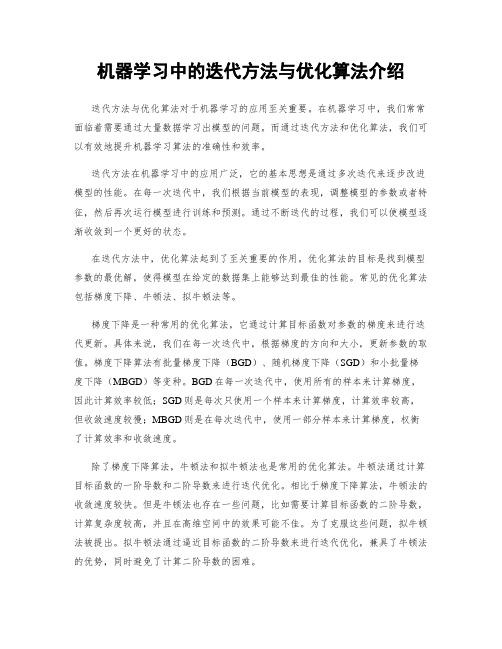
机器学习中的迭代方法与优化算法介绍迭代方法与优化算法对于机器学习的应用至关重要。
在机器学习中,我们常常面临着需要通过大量数据学习出模型的问题。
而通过迭代方法和优化算法,我们可以有效地提升机器学习算法的准确性和效率。
迭代方法在机器学习中的应用广泛,它的基本思想是通过多次迭代来逐步改进模型的性能。
在每一次迭代中,我们根据当前模型的表现,调整模型的参数或者特征,然后再次运行模型进行训练和预测。
通过不断迭代的过程,我们可以使模型逐渐收敛到一个更好的状态。
在迭代方法中,优化算法起到了至关重要的作用。
优化算法的目标是找到模型参数的最优解,使得模型在给定的数据集上能够达到最佳的性能。
常见的优化算法包括梯度下降、牛顿法、拟牛顿法等。
梯度下降是一种常用的优化算法,它通过计算目标函数对参数的梯度来进行迭代更新。
具体来说,我们在每一次迭代中,根据梯度的方向和大小,更新参数的取值。
梯度下降算法有批量梯度下降(BGD)、随机梯度下降(SGD)和小批量梯度下降(MBGD)等变种。
BGD在每一次迭代中,使用所有的样本来计算梯度,因此计算效率较低;SGD则是每次只使用一个样本来计算梯度,计算效率较高,但收敛速度较慢;MBGD则是在每次迭代中,使用一部分样本来计算梯度,权衡了计算效率和收敛速度。
除了梯度下降算法,牛顿法和拟牛顿法也是常用的优化算法。
牛顿法通过计算目标函数的一阶导数和二阶导数来进行迭代优化。
相比于梯度下降算法,牛顿法的收敛速度较快。
但是牛顿法也存在一些问题,比如需要计算目标函数的二阶导数,计算复杂度较高,并且在高维空间中的效果可能不佳。
为了克服这些问题,拟牛顿法被提出。
拟牛顿法通过逼近目标函数的二阶导数来进行迭代优化,兼具了牛顿法的优势,同时避免了计算二阶导数的困难。
除了上述介绍的迭代方法和优化算法,还有许多其他的方法被应用在机器学习中,比如坐标下降法、共轭梯度法、L-BFGS等。
这些方法适用于不同类型的问题和模型,通过选择合适的优化算法,可以有效提升机器学习算法的性能。
机器学习模型的调优与超参数搜索方法研究综述
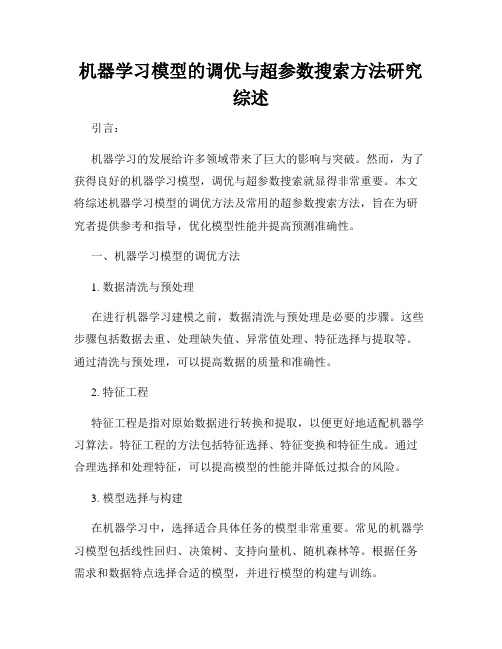
机器学习模型的调优与超参数搜索方法研究综述引言:机器学习的发展给许多领域带来了巨大的影响与突破。
然而,为了获得良好的机器学习模型,调优与超参数搜索就显得非常重要。
本文将综述机器学习模型的调优方法及常用的超参数搜索方法,旨在为研究者提供参考和指导,优化模型性能并提高预测准确性。
一、机器学习模型的调优方法1. 数据清洗与预处理在进行机器学习建模之前,数据清洗与预处理是必要的步骤。
这些步骤包括数据去重、处理缺失值、异常值处理、特征选择与提取等。
通过清洗与预处理,可以提高数据的质量和准确性。
2. 特征工程特征工程是指对原始数据进行转换和提取,以便更好地适配机器学习算法。
特征工程的方法包括特征选择、特征变换和特征生成。
通过合理选择和处理特征,可以提高模型的性能并降低过拟合的风险。
3. 模型选择与构建在机器学习中,选择适合具体任务的模型非常重要。
常见的机器学习模型包括线性回归、决策树、支持向量机、随机森林等。
根据任务需求和数据特点选择合适的模型,并进行模型的构建与训练。
4. 模型评估与选择模型评估是指对构建的模型进行评估和选择。
常用的评估指标包括准确率、精确率、召回率、F1值等。
通过对模型的评估,可以选择表现最好的模型进行后续的调优和应用。
二、超参数搜索方法1. 网格搜索网格搜索是最基本也是最常用的超参数搜索方法之一。
它通过指定每个超参数的候选值,遍历所有可能的组合,选择表现最好的参数组合。
虽然网格搜索简单直观,但是在参数空间较大时会带来较高的计算成本。
2. 随机搜索随机搜索是一种替代网格搜索的方法。
它以随机的方式从给定的超参数空间中采样,选择一组超参数进行评估。
这种方法相对于网格搜索可以减少计算成本,并且在参数空间较大时表现更好。
3. 贝叶斯优化贝叶斯优化是一种基于贝叶斯定理的优化方法。
它通过构建模型来建立参数和模型性能之间的映射关系,并根据不断的模型评估结果来更新模型。
贝叶斯优化可以在有限的迭代次数内找到全局最优解,适用于连续型和离散型参数的优化。
机器学习中几种优化算法的比较(SGD、Momentum、RMSProp、Adam)

机器学习中⼏种优化算法的⽐较(SGD、Momentum、RMSProp、Adam)有关各种优化算法的详细算法流程和公式可以参考【】,讲解⽐较清晰,这⾥说⼀下⾃⼰对他们之间关系的理解。
BGD 与 SGD⾸先,最简单的 BGD 以整个训练集的梯度和作为更新⽅向,缺点是速度慢,⼀个 epoch 只能更新⼀次模型参数。
SGD 就是⽤来解决这个问题的,以每个样本的梯度作为更新⽅向,更新次数更频繁。
但有两个缺点:更新⽅向不稳定、波动很⼤。
因为单个样本有很⼤的随机性,单样本的梯度不能指⽰参数优化的⼤⽅向。
所有参数的学习率相同,这并不合理,因为有些参数不需要频繁变化,⽽有些参数则需要频繁学习改进。
第⼀个问题Mini-batch SGD 和 Momentum 算法做出的改进主要是⽤来解决第⼀个问题。
Mini-batch SGD 算法使⽤⼀⼩批样本的梯度和作为更新⽅向,有效地稳定了更新⽅向。
Momentum 算法则设置了动量(momentum)的概念,可以理解为惯性,使当前梯度⼩幅影响优化⽅向,⽽不是完全决定优化⽅向。
也起到了减⼩波动的效果。
第⼆个问题AdaGrad 算法做出的改进⽤来解决第⼆个问题,其记录了每个参数的历史梯度平⽅和(平⽅是 element-wise 的),并以此表征每个参数变化的剧烈程度,继⽽⾃适应地为变化剧烈的参数选择更⼩的学习率。
但 AdaGrad 有⼀个缺点,即随着时间的累积每个参数的历史梯度平⽅和都会变得巨⼤,使得所有参数的学习率都急剧缩⼩。
RMSProp 算法解决了这个问题,其采⽤了⼀种递推递减的形式来记录历史梯度平⽅和,可以观察其表达式:早期的历史梯度平⽅和会逐渐失去影响⼒,系数逐渐衰减。
Adam简单来讲 Adam 算法就是综合了 Momentum 和 RMSProp 的⼀种算法,其既记录了历史梯度均值作为动量,⼜考虑了历史梯度平⽅和实现各个参数的学习率⾃适应调整,解决了 SGD 的上述两个问题。
机器学习算法的参数调优方法
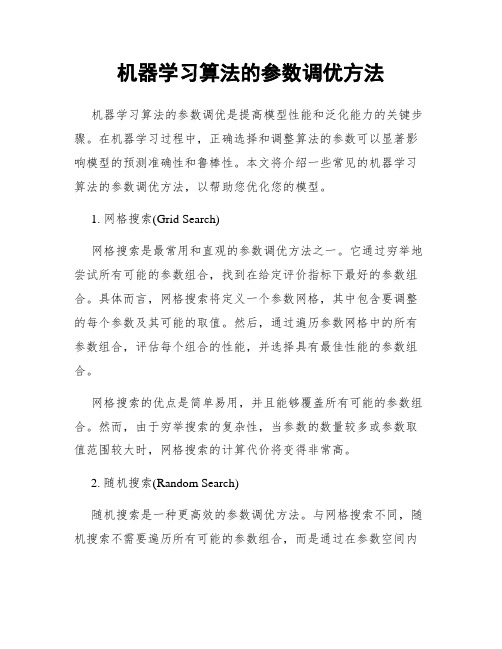
机器学习算法的参数调优方法机器学习算法的参数调优是提高模型性能和泛化能力的关键步骤。
在机器学习过程中,正确选择和调整算法的参数可以显著影响模型的预测准确性和鲁棒性。
本文将介绍一些常见的机器学习算法的参数调优方法,以帮助您优化您的模型。
1. 网格搜索(Grid Search)网格搜索是最常用和直观的参数调优方法之一。
它通过穷举地尝试所有可能的参数组合,找到在给定评价指标下最好的参数组合。
具体而言,网格搜索将定义一个参数网格,其中包含要调整的每个参数及其可能的取值。
然后,通过遍历参数网格中的所有参数组合,评估每个组合的性能,并选择具有最佳性能的参数组合。
网格搜索的优点是简单易用,并且能够覆盖所有可能的参数组合。
然而,由于穷举搜索的复杂性,当参数的数量较多或参数取值范围较大时,网格搜索的计算代价将变得非常高。
2. 随机搜索(Random Search)随机搜索是一种更高效的参数调优方法。
与网格搜索不同,随机搜索不需要遍历所有可能的参数组合,而是通过在参数空间内随机选择参数组合来进行评估。
这种方法更适用于参数空间较大的情况,因为它可以更快地对参数进行搜索和评估。
随机搜索的主要优势是它可以更高效地搜索参数空间,特别是在目标参数与性能之间没有明确的关系时。
然而,随机搜索可能无法找到全局最佳参数组合,因为它没有对参数空间进行全面覆盖。
3. 贝叶斯优化(Bayesian Optimization)贝叶斯优化是一种通过构建模型来优化目标函数的参数调优方法。
它通过根据已经评估过的参数组合的结果来更新对目标函数的概率模型。
然后,通过在参数空间中选择具有高期望改进的参数组合来进行评估。
这种方法有效地利用了先前观察到的信息,并且可以在相对较少的试验次数中找到最佳参数组合。
贝叶斯优化的优点是可以自适应地根据先前的观察结果进行参数选择,并在较少的试验次数中达到较好的性能。
然而,贝叶斯优化的计算代价较高,并且对于大规模数据集可能会面临挑战。
机器学习技术中的迭代算法与优化技巧

机器学习技术中的迭代算法与优化技巧机器学习技术中的迭代算法与优化技巧是现代人工智能领域的重要组成部分。
迭代算法被广泛应用于各种机器学习任务,如分类、回归、聚类等。
通过迭代算法和优化技巧,机器学习模型可以不断优化自身,提升预测精度和性能。
迭代算法的核心思想是通过反复迭代来逐步逼近目标函数的最优解。
在机器学习中,通常会选择使用梯度下降等迭代优化算法来最小化损失函数。
梯度下降算法通过不断更新模型参数,使得模型能够逐渐趋向于最优解。
然而,在实际应用中,简单的梯度下降算法可能面临收敛速度慢、局部最优解等问题。
为了解决这些问题,研究者们提出了一系列优化技巧,以加速迭代过程并改善模型性能。
其中之一是学习率调度。
学习率即参数更新的步长,合理的学习率可以减少迭代次数,加快收敛速度。
学习率调度包括固定学习率、衰减学习率和自适应学习率等。
固定学习率适用于简单的问题,但对于复杂问题,衰减学习率或自适应学习率更能获得更好的效果。
另一个重要的优化技巧是正则化。
正则化主要用于解决过拟合问题,通过在损失函数中添加正则化项,惩罚过大的模型参数,使其不过分依赖于训练数据,提高模型的泛化性能。
常见的正则化方法有L1正则化和L2正则化。
L1正则化可以产生稀疏模型,即使得一些特征的权重变为零,从而实现特征选择的作用。
而L2正则化可以平滑模型参数,更加鲁棒。
此外,优化技巧还包括随机梯度下降、批量梯度下降和小批量梯度下降等。
随机梯度下降每次随机选择一个样本进行梯度更新,计算速度快但不稳定。
批量梯度下降每次使用全部样本计算梯度,能够获得全局最优解,但计算开销较大。
小批量梯度下降则折中了两者的优缺点,使用一小部分样本计算梯度,既节省了计算开销又提高了稳定性。
除了上述优化技巧,还有很多其他的方法可以进一步提升机器学习模型的性能,例如动量法、自适应优化算法(如Adam、RMSProp)等。
这些方法都是为了更好地解决机器学习中的优化问题,提高模型的学习能力和泛化能力。
机器学习中的梯度下降和Adam优化算法

机器学习中的梯度下降和Adam优化算法随着人工智能的不断发展,机器学习算法成为了许多领域中不可或缺的一部分。
而在机器学习的算法中,梯度下降和Adam优化算法十分重要,本文将对二者进行详细介绍。
一、梯度下降算法梯度下降算法是一种迭代算法,用于优化目标函数。
它是通过不断计算函数的梯度来沿着目标函数的最陡峭方向寻找最优解的过程。
在机器学习中,我们通常使用梯度下降算法来求解最小化损失函数的参数。
梯度下降算法有三种形式:批量(Batch)梯度下降、随机(Stochastic)梯度下降和小批量(Mini-batch)梯度下降。
1.1 批量梯度下降算法批量梯度下降算法会在每一次迭代中使用全部训练数据集进行运算,然后根据梯度的反向传播更新参数。
但是,批量梯度下降算法的缺点是计算速度慢。
当数据集很大时,需要很多计算能力和内存空间才能处理,一次迭代需要耗费大量时间和资源。
1.2 随机梯度下降算法随机梯度下降算法不使用全部的训练数据集进行运算,而是在每一次迭代时随机选择一个数据进行运算。
对于其中每个数据的更新来说,具有很好的随机性,从而能够达到良好的代替。
但是,随机梯度下降算法的缺点是运算速度快,但存在一定的不稳定性和噪声,容易陷入局部最优解或不收敛。
1.3 小批量梯度下降算法小批量梯度下降算法介于批量梯度下降算法和随机梯度下降算法之间。
它每次处理多个数据,通常在10-1000个数据之间。
因此,可以利用较小数量的训练数据集进行运算,节省了计算时间和内存资源,同时也降低了不稳定性和噪声。
二、Adam优化算法Adam优化算法是目前最流行的优化算法之一,它基于梯度下降算法并结合了RMSprop和Momentum优化算法的思想。
它不仅可以根据之前的自适应动态调整学习率,而且可以自适应地计算每个参数的学习率。
Adam优化算法的更新公式如下:$$t = t + 1$$$$g_{t} = \nabla_{\theta} J(\theta)$$$$m_{t} = \beta_1 m_{t-1} + (1 - \beta_1) g_{t}$$$$v_{t} = \beta_2 v_{t-1} + (1 - \beta_2) g_{t}^2$$$$\hat{m}_{t} = \dfrac{m_{t}}{1 - \beta_1^t}$$$$\hat{v}_{t} = \dfrac{v_{t}}{1 - \beta_2^t}$$$$\theta_{t+1} = \theta_{t} - \dfrac{\alpha}{\sqrt{\hat{v}_{t}} +\epsilon} \hat{m}_{t}$$其中,$g_{t}$是当前梯度,$m_{t}$和$v_{t}$分别表示当前的一阶和二阶矩估计,$\beta_1$和$\beta_2$是平滑参数,$\hat{m}_{t}$和$\hat{v}_{t}$是对一阶和二阶矩的偏差校正,$\alpha$是学习速率,$\epsilon$是防止除数为零的数值稳定项。
几种仿生优化算法综述

几种仿生优化算法综述随着人工智能和机器学习领域的发展,优化算法在解决各种问题中扮演着重要角色。
而仿生优化算法是众多优化算法之一,其灵感来源于自然界中各种生物的生存策略。
本文将对几种常见的仿生优化算法进行综述。
1. 遗传算法遗传算法是基于遗传学和进化论理论的优化算法。
该算法利用自然选择、交叉和突变等操作作为主要算子来生成优化解。
该算法适用于那些没有显式数学模型或复杂的非线性目标函数的情况。
遗传算法已被广泛应用于组合优化,函数优化,机器学习等领域。
2. 粒子群优化算法粒子群优化算法仿照鸟群和鱼群等天然集体行为的方式来搜索最优解。
每个粒子表示一个潜在的优化解,并在搜索空间中移动。
每个粒子的移动速度和方向通过当前的最优解和群体最优解来确定。
该算法在连续优化、非线性问题、复杂约束问题中表现出了很好的性能。
3. 人工鱼群算法人工鱼群算法是一种基于鱼群行为的优化算法。
算法中包含一个鱼群,每个鱼代表一个解,并通过寻找食物来更新其位置。
在搜索过程中,鱼可以根据当前的环境和周围鱼的行为来调整其移动方向。
该算法可以应用于连续优化、离散优化和多目标优化等问题中。
4. 蚁群算法蚁群算法模拟了蚂蚁寻找食物的行为。
在该算法中,每个蚂蚁的行为对整个群体的行为有影响。
蚂蚁会通过移动、放置信息素和蒸发信息素等方式在搜索空间中寻找最优解。
该算法已被成功应用于组合优化、连续优化和离散优化等问题中。
5. 免疫算法免疫算法是一种基于生物免疫的优化算法。
该算法包括抗体和克隆算法。
抗体代表优化解,而克隆算法用于生成新的解。
克隆算法通常会在好的解附近产生更多的解,以加速搜索过程。
该算法已被广泛应用于组合优化、连续优化和多目标优化等领域。
总之,各种仿生优化算法都有不同的优势和适用范围。
在实际应用中,我们可以根据问题特点选择适宜的算法来解决问题。
机器学习模型优化方法的研究综述
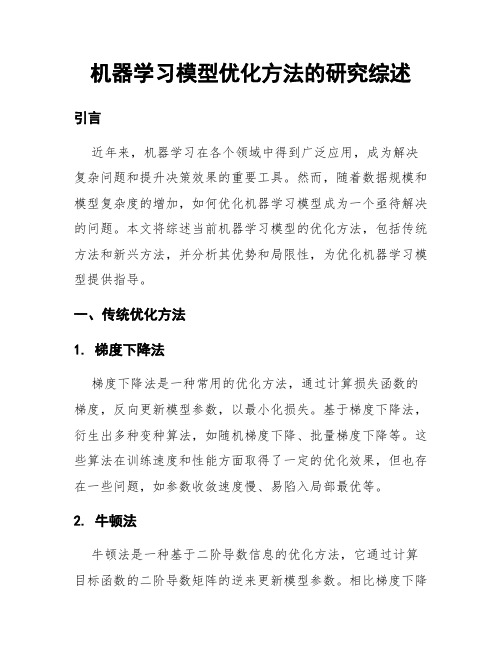
机器学习模型优化方法的研究综述引言近年来,机器学习在各个领域中得到广泛应用,成为解决复杂问题和提升决策效果的重要工具。
然而,随着数据规模和模型复杂度的增加,如何优化机器学习模型成为一个亟待解决的问题。
本文将综述当前机器学习模型的优化方法,包括传统方法和新兴方法,并分析其优势和局限性,为优化机器学习模型提供指导。
一、传统优化方法1. 梯度下降法梯度下降法是一种常用的优化方法,通过计算损失函数的梯度,反向更新模型参数,以最小化损失。
基于梯度下降法,衍生出多种变种算法,如随机梯度下降、批量梯度下降等。
这些算法在训练速度和性能方面取得了一定的优化效果,但也存在一些问题,如参数收敛速度慢、易陷入局部最优等。
2. 牛顿法牛顿法是一种基于二阶导数信息的优化方法,它通过计算目标函数的二阶导数矩阵的逆来更新模型参数。
相比梯度下降法,牛顿法收敛速度更快,并且可以更准确地找到全局最优解。
然而,牛顿法的计算复杂度较高,并且需要对目标函数进行二阶导数的计算,对于大规模数据和复杂模型来说,计算成本非常高。
3. 正则化正则化方法通过在目标函数中加入正则项,限制模型的复杂度,以防止过拟合现象的发生。
常见的正则化方法包括L1正则化和L2正则化。
L1正则化通过将模型参数的绝对值作为正则项,促使模型的稀疏性。
L2正则化则通过将模型参数的平方和作为正则项,使模型参数尽量接近零。
正则化方法能够有效提升模型的泛化能力,防止过拟合,但也会引入一定的偏差。
二、新兴优化方法1. 深度学习优化方法深度学习作为最近研究的热点领域,为机器学习模型优化带来了新的思路和方法。
其中,基于梯度的优化方法是深度学习中应用最广泛的方法之一。
通过使用反向传播算法计算梯度,并结合学习率调整策略,深度学习模型能够在高维度问题中迅速收敛,取得较好的优化效果。
此外,还有基于牛顿法的优化方法,如拟牛顿法,通过近似计算目标函数的二阶导数,加速模型的优化过程。
2. 元学习元学习是机器学习中的一种新兴方法,旨在通过学习优化算法的策略,使模型能够更快、更准确地适应新任务。
智能优化算法综述
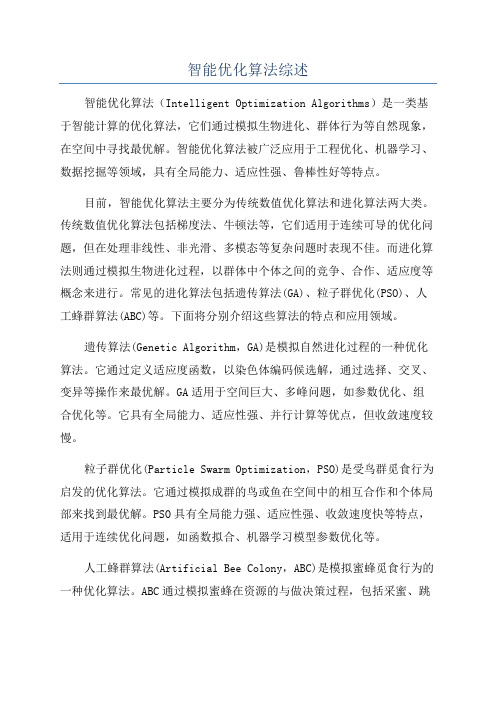
智能优化算法综述智能优化算法(Intelligent Optimization Algorithms)是一类基于智能计算的优化算法,它们通过模拟生物进化、群体行为等自然现象,在空间中寻找最优解。
智能优化算法被广泛应用于工程优化、机器学习、数据挖掘等领域,具有全局能力、适应性强、鲁棒性好等特点。
目前,智能优化算法主要分为传统数值优化算法和进化算法两大类。
传统数值优化算法包括梯度法、牛顿法等,它们适用于连续可导的优化问题,但在处理非线性、非光滑、多模态等复杂问题时表现不佳。
而进化算法则通过模拟生物进化过程,以群体中个体之间的竞争、合作、适应度等概念来进行。
常见的进化算法包括遗传算法(GA)、粒子群优化(PSO)、人工蜂群算法(ABC)等。
下面将分别介绍这些算法的特点和应用领域。
遗传算法(Genetic Algorithm,GA)是模拟自然进化过程的一种优化算法。
它通过定义适应度函数,以染色体编码候选解,通过选择、交叉、变异等操作来最优解。
GA适用于空间巨大、多峰问题,如参数优化、组合优化等。
它具有全局能力、适应性强、并行计算等优点,但收敛速度较慢。
粒子群优化(Particle Swarm Optimization,PSO)是受鸟群觅食行为启发的优化算法。
它通过模拟成群的鸟或鱼在空间中的相互合作和个体局部来找到最优解。
PSO具有全局能力强、适应性强、收敛速度快等特点,适用于连续优化问题,如函数拟合、机器学习模型参数优化等。
人工蜂群算法(Artificial Bee Colony,ABC)是模拟蜜蜂觅食行为的一种优化算法。
ABC通过模拟蜜蜂在资源的与做决策过程,包括采蜜、跳舞等行为,以找到最优解。
ABC具有全局能力强、适应性强、收敛速度快等特点,适用于连续优化问题,如函数优化、机器学习模型参数优化等。
除了上述三种算法,还有模拟退火算法(Simulated Annealing,SA)、蚁群算法(Ant Colony Optimization,ACO)、混沌优化算法等等。
了解机器学习中的梯度优化算法
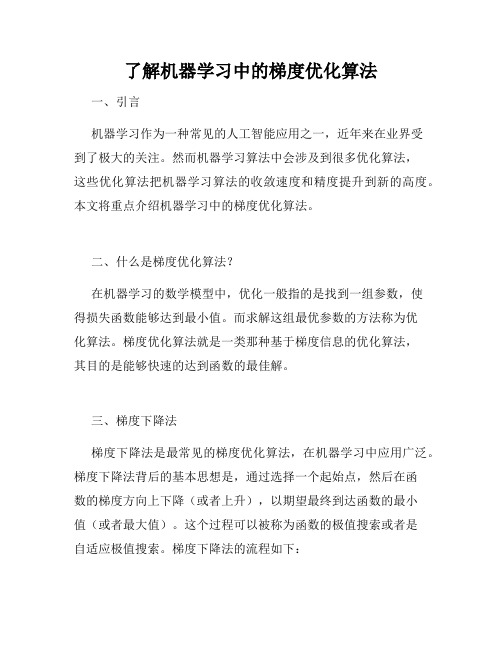
了解机器学习中的梯度优化算法一、引言机器学习作为一种常见的人工智能应用之一,近年来在业界受到了极大的关注。
然而机器学习算法中会涉及到很多优化算法,这些优化算法把机器学习算法的收敛速度和精度提升到新的高度。
本文将重点介绍机器学习中的梯度优化算法。
二、什么是梯度优化算法?在机器学习的数学模型中,优化一般指的是找到一组参数,使得损失函数能够达到最小值。
而求解这组最优参数的方法称为优化算法。
梯度优化算法就是一类那种基于梯度信息的优化算法,其目的是能够快速的达到函数的最佳解。
三、梯度下降法梯度下降法是最常见的梯度优化算法,在机器学习中应用广泛。
梯度下降法背后的基本思想是,通过选择一个起始点,然后在函数的梯度方向上下降(或者上升),以期望最终到达函数的最小值(或者最大值)。
这个过程可以被称为函数的极值搜索或者是自适应极值搜索。
梯度下降法的流程如下:1.选择任意一个参数值,作为起始点;2.计算梯度方向和大小;3.根据梯度方向更新参数;4.重复2和3,直到达到预定的终止条件。
梯度下降法的缺点是在计算上容易受到局部极值的干扰。
此外,这种算法需要宏观地选择学习率;学习率太小,收敛需要很多次迭代;学习率太大,则可能导致震荡或者不收敛。
在工程中梯度下降法已经得以成功应用到了许多机器学习应用中。
四、随机梯度下降法随机梯度下降法在梯度下降的基础上进行了改进,在处理大规模数据的机器学习问题时是最受欢迎的优化算法之一。
随机梯度下降法以一小部分的数据集(即批次)来更新模型的参数。
随机梯度下降法可以看作是将梯度下降法中的“批量”改成了“随机”。
它的一般流程如下:1.选择任意一个参数值,作为起始点;2.从数据集中随机选取一个样本,计算它的梯度方向和大小;3.根据样本的梯度方向更新参数;4.重复2和3,直到达到预定的终止条件。
相对于梯度下降法,随机梯度下降法可以更加快速地收敛,但是收敛的结果不是非常的精确。
此外,虽然随机梯度下降法快速,但是在调整学习率方面需要花费更多的时间和精力。
机器学习中的算法优化和分类
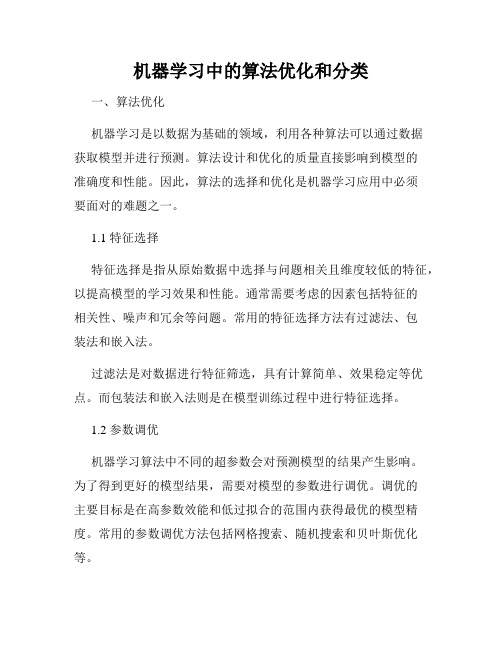
机器学习中的算法优化和分类一、算法优化机器学习是以数据为基础的领域,利用各种算法可以通过数据获取模型并进行预测。
算法设计和优化的质量直接影响到模型的准确度和性能。
因此,算法的选择和优化是机器学习应用中必须要面对的难题之一。
1.1 特征选择特征选择是指从原始数据中选择与问题相关且维度较低的特征,以提高模型的学习效果和性能。
通常需要考虑的因素包括特征的相关性、噪声和冗余等问题。
常用的特征选择方法有过滤法、包装法和嵌入法。
过滤法是对数据进行特征筛选,具有计算简单、效果稳定等优点。
而包装法和嵌入法则是在模型训练过程中进行特征选择。
1.2 参数调优机器学习算法中不同的超参数会对预测模型的结果产生影响。
为了得到更好的模型结果,需要对模型的参数进行调优。
调优的主要目标是在高参数效能和低过拟合的范围内获得最优的模型精度。
常用的参数调优方法包括网格搜索、随机搜索和贝叶斯优化等。
1.3 模型集成模型集成是将多个单一模型组合成一个预测模型,以提高预测性能。
常用的模型集成方法包括投票、平均化、Bagging、Boosting 和Stacking等。
集成技术可以通过平衡不同模型的优点来提高模型的准确度、泛化能力和鲁棒性。
二、分类算法2.1 传统分类算法传统分类算法分为监督学习和无监督学习两种。
监督学习是一种通过已经标记好的训练样本训练模型,以预测新输入数据的性质和类别的方法。
常见的监督学习算法包括线性回归、逻辑回归、SVM、朴素贝叶斯和决策树等。
无监督学习则是一种通过不需要预先确定类别标准的非监督式数据学习过程,其主要任务是以某种方式对数据进行分类。
通常的无监督学习算法包括聚类分析、自组织映射和异常检测等。
2.2 深度学习分类算法深度学习是机器学习中的一个分支,以多层神经网络为基础,通过学习从数据到一些有用的表征来识别模式、分类对象等任务。
深度学习分类算法在处理自然语言处理、图像识别和语音识别等情况下表现出色。
其中,深度神经网络(Deep Neural Networks,DNN)可以通过层数的增加和网络结构的优化来提高模型的精度和效率。
机器学习知识:机器学习中的贝叶斯优化
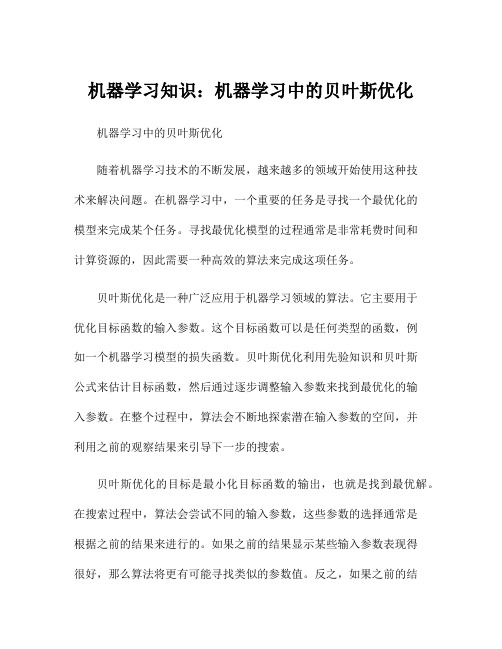
机器学习知识:机器学习中的贝叶斯优化机器学习中的贝叶斯优化随着机器学习技术的不断发展,越来越多的领域开始使用这种技术来解决问题。
在机器学习中,一个重要的任务是寻找一个最优化的模型来完成某个任务。
寻找最优化模型的过程通常是非常耗费时间和计算资源的,因此需要一种高效的算法来完成这项任务。
贝叶斯优化是一种广泛应用于机器学习领域的算法。
它主要用于优化目标函数的输入参数。
这个目标函数可以是任何类型的函数,例如一个机器学习模型的损失函数。
贝叶斯优化利用先验知识和贝叶斯公式来估计目标函数,然后通过逐步调整输入参数来找到最优化的输入参数。
在整个过程中,算法会不断地探索潜在输入参数的空间,并利用之前的观察结果来引导下一步的搜索。
贝叶斯优化的目标是最小化目标函数的输出,也就是找到最优解。
在搜索过程中,算法会尝试不同的输入参数,这些参数的选择通常是根据之前的结果来进行的。
如果之前的结果显示某些输入参数表现得很好,那么算法将更有可能寻找类似的参数值。
反之,如果之前的结果不太好,那么算法将选择更不同的参数值。
这种方法保证了算法在搜索空间中尽可能多地探索,以找到最优化的输入参数。
贝叶斯优化有很多实际应用。
例如,在机器学习中,我们需要为模型选择超参数。
超参数是控制模型行为的变量,例如正则化参数或学习速率。
这些变量的选择将极大地影响模型的性能。
在贝叶斯优化中,我们可以定义目标函数为模型在验证集上的性能,然后寻找超参数的最优化解。
在另一个例子中,假设我们正在尝试设计具有最佳性能的电子元件。
我们可以将电子元件的特征作为输入参数,并使用贝叶斯优化来最小化电子元件在某个测试条件下的性能。
贝叶斯优化对于模型选择或超参优化等问题的解决非常有帮助。
然而,它并不总是最快的方法。
在一些特殊的情况下,例如需要同时优化多个目标函数或一些非光滑函数时,贝叶斯优化可能需要很长时间才能得到结果。
在这种情况下,其他快速的优化算法可能更适合。
总的来说,贝叶斯优化是机器学习领域一种非常重要的优化算法。
大规模机器学习中的分布式算法与优化

大规模机器学习中的分布式算法与优化随着人工智能技术的不断发展,机器学习已经成为各行各业的热门话题。
大规模机器学习涉及的数据量往往非常之大,单机处理效率已经无法满足需求。
因此,分布式算法和优化技术成为了大规模机器学习领域的热点问题。
一、背景随着各个领域数据的爆炸式增长,以及更高的算法复杂度,使得单机的计算能力已经不能满足大规模机器学习的需求。
分布式计算,即通过将计算资源分布在多台计算机中来提高计算效率,成为了处理海量数据的有效手段。
二、分布式算法分布式算法的核心在于如何将单机算法映射到分布式计算框架中,以便实现并行化计算。
常见的分布式计算框架包括Hadoop、Spark、Flink等,它们各自具有不同的特点和优势。
对于一些常见的机器学习算法,例如逻辑回归、SVM、神经网络等,已有一定的分布式算法实现。
这些算法的分布式实现,通常需要解决以下几个关键问题:1.数据划分:将原始数据集划分成多个数据块,并分配到不同的计算节点中,以便实现并行处理。
2.计算并发控制:在分布式计算中,需要保证数据在不同的节点上能够顺利地流动,而不会出现数据丢失或重复。
此外,不同节点之间的计算进度也需要有所控制,以避免部分节点的计算速度过慢导致整体性能下降。
3.计算结果聚合:分布式计算中,不同节点上的计算结果需要进行合并,以得到最终的计算结果。
合并的方式通常包括平均、加权平均、投票等。
以上三个问题,是分布式算法实现中需要解决的关键问题。
三、分布式优化除了分布式算法之外,分布式优化也是大规模机器学习中的重要组成部分。
分布式优化旨在优化各个计算节点上的计算结果,使得整体的计算结果更加优秀。
常见的分布式优化算法包括SGD、ADMM、DANE等。
分布式优化算法的核心在于如何将单机优化算法映射到分布式计算框架中,以便实现并行化优化计算。
通常,分布式优化算法需要解决以下几个问题:1.变量划分:将原始优化问题划分成多个子问题,并将每个子问题分配到不同的计算节点中,并在节点间进行变量交换/同步,以实现并行计算。
机器学习技术中的聚类算法与模型优化方法
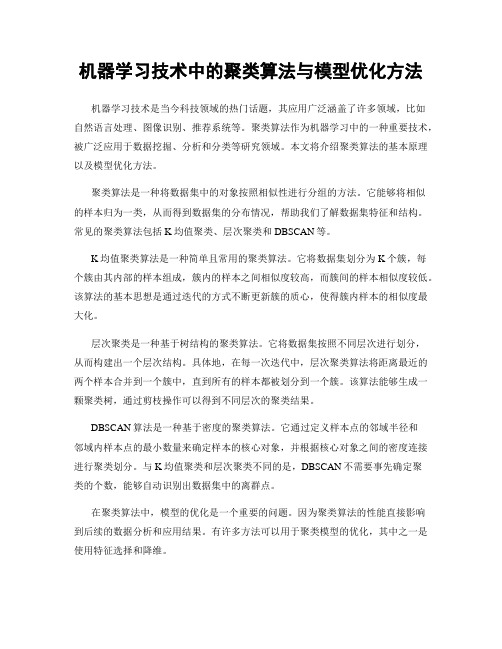
机器学习技术中的聚类算法与模型优化方法机器学习技术是当今科技领域的热门话题,其应用广泛涵盖了许多领域,比如自然语言处理、图像识别、推荐系统等。
聚类算法作为机器学习中的一种重要技术,被广泛应用于数据挖掘、分析和分类等研究领域。
本文将介绍聚类算法的基本原理以及模型优化方法。
聚类算法是一种将数据集中的对象按照相似性进行分组的方法。
它能够将相似的样本归为一类,从而得到数据集的分布情况,帮助我们了解数据集特征和结构。
常见的聚类算法包括K均值聚类、层次聚类和DBSCAN等。
K均值聚类算法是一种简单且常用的聚类算法。
它将数据集划分为K个簇,每个簇由其内部的样本组成,簇内的样本之间相似度较高,而簇间的样本相似度较低。
该算法的基本思想是通过迭代的方式不断更新簇的质心,使得簇内样本的相似度最大化。
层次聚类是一种基于树结构的聚类算法。
它将数据集按照不同层次进行划分,从而构建出一个层次结构。
具体地,在每一次迭代中,层次聚类算法将距离最近的两个样本合并到一个簇中,直到所有的样本都被划分到一个簇。
该算法能够生成一颗聚类树,通过剪枝操作可以得到不同层次的聚类结果。
DBSCAN算法是一种基于密度的聚类算法。
它通过定义样本点的邻域半径和邻域内样本点的最小数量来确定样本的核心对象,并根据核心对象之间的密度连接进行聚类划分。
与K均值聚类和层次聚类不同的是,DBSCAN不需要事先确定聚类的个数,能够自动识别出数据集中的离群点。
在聚类算法中,模型的优化是一个重要的问题。
因为聚类算法的性能直接影响到后续的数据分析和应用结果。
有许多方法可以用于聚类模型的优化,其中之一是使用特征选择和降维。
特征选择是从原始数据集中选择对聚类任务最有用的特征子集。
通过选择重要特征,可以降低数据维度,减少数据集的噪声和冗余信息,提高聚类算法的性能。
常见的特征选择方法包括方差阈值法、相关系数法和基于模型的方法等。
降维是将高维数据映射到低维空间的过程。
通过降维,可以减少数据集的复杂性,提高聚类算法的效率和准确性。
智能优化算法综述

智能优化算法综述智能优化算法是一类基于生物进化、群体智慧、神经网络等自然智能的优化算法的统称。
与传统优化算法相比,智能优化算法可以更好地解决高维、非线性、非凸以及复杂约束等问题,具有全局能力和较高的优化效果。
在实际应用中,智能优化算法已经广泛应用于机器学习、数据挖掘、图像处理、工程优化等领域。
常见的智能优化算法包括遗传算法、粒子群优化算法、蚁群算法、模拟退火算法、人工免疫算法、蜂群算法等。
这些算法都具有模拟自然进化、群体智慧等特点,通过不断优化解的候选集合,在参数空间中寻找最优解。
遗传算法是一种基于进化论的智能优化算法,在解决寻优问题时非常有效。
它基于染色体、基因、进化等概念,通过模拟自然进化的过程进行全局。
遗传算法通过选择、交叉、变异等操作来生成新的解,并根据适应度函数判断解的优劣。
遗传算法的优势在于能够在空间中进行快速全局,并适用于复杂约束问题。
粒子群优化算法是一种模拟鸟群觅食行为的智能优化算法。
粒子群算法通过模拟粒子在解空间中的过程,不断更新速度和位置,从而寻找最优解。
粒子群算法的优势在于能够迅速收敛到局部最优解,并具有较强的全局能力。
蚁群算法模拟了蚁群在寻找食物和建立路径上的行为,在解决优化问题时较为常用。
蚁群算法通过模拟蚂蚁释放信息素的过程,引导蚁群在解空间中的行为。
蚂蚁根据信息素浓度选择前进路径,并在路径上释放信息素,从而引导其他蚂蚁对该路径的选择。
蚁群算法具有良好的全局能力和自适应性。
模拟退火算法模拟了固体物质退火冷却的过程,在解决优化问题时具有较好的效果。
模拟退火算法通过接受更差解的机制,避免陷入局部最优解。
在过程中,模拟退火算法根据一定的退火规则和能量函数冷却系统,以一定的概率接受新的解,并逐渐降低温度直至收敛。
模拟退火算法具有较强的全局能力和免疫局部最优解能力。
人工免疫算法模拟了人类免疫系统对抗入侵的过程,在解决优化问题时表现出较好的鲁棒性和全局能力。
人工免疫算法通过模拟免疫系统的机制进行,不断生成、选择、演化解,并通过抗体、抗原等概念来刻画解的特征。
机器学习算法的优化

机器学习算法的优化机器学习算法的优化是指通过对算法进行改进和调整,使得其在解决问题时能够更加准确、高效和稳定。
在机器学习领域中,算法的优化是一个不断探索和研究的过程,旨在提高模型的预测性能和泛化能力。
本文将从以下几个方面来讨论机器学习算法的优化。
一、数据预处理数据预处理是机器学习算法优化的重要一环。
通常情况下,原始数据可能存在噪声、缺失值、异常值等问题,这些问题会影响模型的性能。
因此,在使用机器学习算法之前,需要对数据进行预处理,包括数据清洗、特征选择与转换等。
数据清洗是指检测和修复数据中的错误、缺失值等问题;特征选择与转换是指选择对预测任务有意义且相关的特征,并对这些特征进行适当的变换,以提取更有用的信息。
二、模型选择与调参在机器学习中,选择合适的模型对于算法的优化至关重要。
不同的问题可能适用于不同的模型,因此,在应用机器学习算法之前需要根据具体的问题需求来选择适合的模型。
同时,模型中的参数也会影响算法的性能,因此需要进行调参,即通过调整参数的取值来寻找最佳的模型性能。
常用的方法包括网格搜索、随机搜索、贝叶斯优化等。
三、交叉验证与模型评估为了评估模型的泛化能力和性能,交叉验证是一个常用的方法。
通过将数据集划分为训练集和测试集,并多次重复进行训练和测试,可以得到对模型性能的综合评估。
常见的交叉验证方法包括k折交叉验证和留一交叉验证。
在交叉验证过程中,可以使用不同的评估指标来度量模型的性能,比如准确率、精确率、召回率、F1值等,选择适合问题需求的评估指标来评估模型。
四、集成学习集成学习是一种通过组合多个弱学习器来构建一个强学习器的方法。
通过结合多个模型的预测结果,集成学习可以提高模型的准确性和鲁棒性。
常见的集成学习方法包括随机森林、梯度提升树等。
在使用集成学习方法时,需要选择合适的基学习器、集成策略和调参策略,以提高集成模型的性能。
五、特征工程的优化特征工程是指根据具体问题的需求,从原始数据中提取更加有效的特征。
机器学习中的加速一阶优化算法
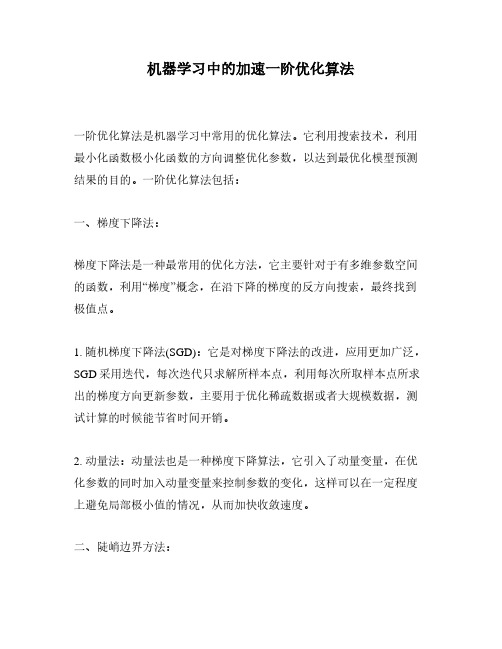
机器学习中的加速一阶优化算法一阶优化算法是机器学习中常用的优化算法。
它利用搜索技术,利用最小化函数极小化函数的方向调整优化参数,以达到最优化模型预测结果的目的。
一阶优化算法包括:一、梯度下降法:梯度下降法是一种最常用的优化方法,它主要针对于有多维参数空间的函数,利用“梯度”概念,在沿下降的梯度的反方向搜索,最终找到极值点。
1. 随机梯度下降法(SGD):它是对梯度下降法的改进,应用更加广泛,SGD采用迭代,每次迭代只求解所样本点,利用每次所取样本点所求出的梯度方向更新参数,主要用于优化稀疏数据或者大规模数据,测试计算的时候能节省时间开销。
2. 动量法:动量法也是一种梯度下降算法,它引入了动量变量,在优化参数的同时加入动量变量来控制参数的变化,这样可以在一定程度上避免局部极小值的情况,从而加快收敛速度。
二、陡峭边界方法:陡峭边界方法是另一种有效的一阶优化算法,它将优化问题转换成求解一个小球在多维空间跳动求解原点问题。
在这种方法中,对参数做出移动及修正操作,同时,利用拐点和弥散符合,实时调整参数搜索方向,以达到收敛到最优解的目的。
1. 共轭梯度法:它是最常用的算法,采用最快下降法和陡峭边界方法的结合体,进行统一的参数调整,并且不断的更新搜索方向。
2. LBFGS算法:LBFGS(Limited-memory Broyden-Fletcher-Goldfarb-Shanno)同样使用共轭梯度方法,在这种方法中,减少了随机的计算量,通过评估一定个数的搜索步骤,并维护开销小的内存,以计算出搜索方向。
三、其他一阶优化算法:1. Adagrad算法:Adagrad算法是一种专门为稀疏数据集设计的优化方法,它采用“自适应”学习率原则,通过偏导数以及参数的规模和变化,改变学习率的大小,达到调整收敛状态的目的。
2. RMSProp:RMSProp是一种自适应学习率优化算法,它通过“梯度过去平方和的衰减平均”来更新学习率,它可以赋予参数不同的学习率,如果学习率较小,则对参数估计更加稳定;如果学习率较大,则可以快速搜索到最优解。
机器学习中的优化算法
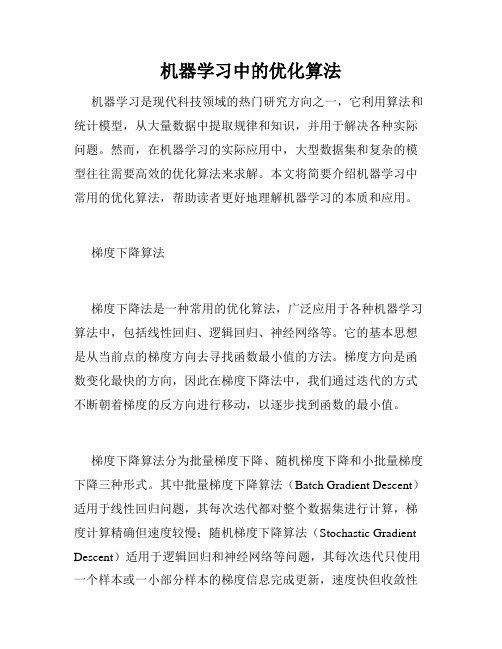
机器学习中的优化算法机器学习是现代科技领域的热门研究方向之一,它利用算法和统计模型,从大量数据中提取规律和知识,并用于解决各种实际问题。
然而,在机器学习的实际应用中,大型数据集和复杂的模型往往需要高效的优化算法来求解。
本文将简要介绍机器学习中常用的优化算法,帮助读者更好地理解机器学习的本质和应用。
梯度下降算法梯度下降法是一种常用的优化算法,广泛应用于各种机器学习算法中,包括线性回归、逻辑回归、神经网络等。
它的基本思想是从当前点的梯度方向去寻找函数最小值的方法。
梯度方向是函数变化最快的方向,因此在梯度下降法中,我们通过迭代的方式不断朝着梯度的反方向进行移动,以逐步找到函数的最小值。
梯度下降算法分为批量梯度下降、随机梯度下降和小批量梯度下降三种形式。
其中批量梯度下降算法(Batch Gradient Descent)适用于线性回归问题,其每次迭代都对整个数据集进行计算,梯度计算精确但速度较慢;随机梯度下降算法(Stochastic Gradient Descent)适用于逻辑回归和神经网络等问题,其每次迭代只使用一个样本或一小部分样本的梯度信息完成更新,速度快但收敛性差;小批量梯度下降算法(Mini-Batch Gradient Descent)综合了两种算法的优点,使用一些数据子集的梯度来更新模型参数,速度和精度都比较好。
共轭梯度算法共轭梯度算法(Conjugate Gradient)是一种有效的线性方程求解算法,通常用于解决线性回归问题。
与梯度下降算法不同的是,共轭梯度算法在每次求解时,利用已知信息来更新解向量,因此具有较快的收敛速度和较低的计算成本。
共轭梯度算法的核心思想是利用共轭特性来加速求解过程。
在共轭梯度算法中,我们需要先计算残差向量$r_0=b-Ax_0$,其中$b$为已知的向量,$A$为已知的矩阵,$x_0$为初始估计向量。
然后,将残差向量$r_0$作为第一个搜索方向$d_0$,然后对每个方向$d_i$和之前所有方向进行共轭计算,得到新的搜索方向$d_i$,以此类推,一直到找到解或满足收敛条件。
- 1、下载文档前请自行甄别文档内容的完整性,平台不提供额外的编辑、内容补充、找答案等附加服务。
- 2、"仅部分预览"的文档,不可在线预览部分如存在完整性等问题,可反馈申请退款(可完整预览的文档不适用该条件!)。
- 3、如文档侵犯您的权益,请联系客服反馈,我们会尽快为您处理(人工客服工作时间:9:00-18:30)。
Tutorial on
Optimization methods for machine learning
Jorge Nocedal
Northwestern University
Overview 1. We discuss some characteristics of optimization problems arising in deep learning, convex logistic regression and inverse covariance estimation. 2. There are many tools at our disposal: first and second order methods; batch and stochastic algorithms; regularization; primal and dual approaches; parallel computing 3. Yet the state of affairs with neural nets is confusing to me: too many challenges are confronted at once: local vs local minima, nonlinearity, stochasticity, initializations, heuristics
pk = −rk + β k pk−1
p Ark βk = T pk −1 Apk −1
T k −1
Only product Apk is needed Hessian-free
Choose some initial point: x0 Initial direction: p0 = −r0 For x0 = 0, -r0 = b
6
Part I Problem Characteristics and Second Order Methods
7
Nonlinearity, Ill Conditioning Neural nets are far more nonlinear than the functions minimized in many other applications Farabet The rate of convergence of an optimization algorithm is still important even though in practice one stops the iteration far from a minimizer”
Problem: min f (x)
(Hessian Free)
∇ 2 f (xk )p = −∇f (xk ) xk +1 = xk + α p
- This is a linear system of equations of size n - Apply the Conjugate Gradient (CG) method to compute an approximate solution to this system - CG is an iterative method endowed with very interesting properties (optimal Krylov method) - Hessian need not be computed explicitly - Continuum between 1st and 2nd order methods
4
My Background Most of my practical experience in optimization methods for machine learning is for speech recognition (Google) But I am aware of many tests done in a variety of machine learning applications due to my involvement in L-BFGS, Newton-CG methods (Hessian-free), dynamic sampling methods, etc I am interested in designing new optimization methods for machine applications, in particular for deep learning
Interaction between CG and Newton
We noted -r = b if x0 = 0
For the linear system
∇ 2 f (xk )p = −∇f (xk ) Ax = b r = Ax −b → b = − ∇f (xk )
Conclusion: if we terminate the CG algorithm after 1 iteration we obtain a steepest descent step
3
Organization I will discuss a few of optimization techniques and provide some insights into their strengths and weaknesses We will contrast the deterministic and stochastic settings. This motivates dynamic sample selection methods We emphasize the need for general purpose techniques, second order methods and scale invariance, vs heuristics
The conjugate gradient method
Two equivalent problems
1 T min φ (x) = x Ax − bT x ∇φ (x) = Ax − b 2 solve Ax = b r = Ax − b
Newton-CG: the Convex Case
∇ 2 f (xk )p = −∇f (xk )
- We show below that any number of CG iterations yield a productive step - Not true of other iterative methods - better direction and length than 1st order methods
8
An objective function (Le,…Ng)
9
General Formulation
1 m min J (w) = ∑ (w;(zi , yi )) + ν || w ||1 m i =1
(z i , y i ) training data zi vector of features;
Difficult to choose γ . Trust region method learns γ
The Nonconvex Case: Alternatives
Replace ∇ 2 f (xk ) by a positive definite approximation Bp = −∇f (x0 ) Option 1: Gauss-Newton Matrix J(xk )J(xk )T Option 2: Stop CG early - negative curvature Option 3: Trust region approach
1
n Newton
Steepest descent
Rates of Convergence – Scale Invariance
The rate of convergence can be: linear superlinear quadratic depending on the accuracy of the CG solution • It inherits some of the scale invariance properties of the exact Newton method: affine change of variables x ← Dx
Let λ1 ≤ λ2 ≤ ... ≤ λn be the eigenvalues of ∇ 2 f (x0 ). Then the eigenvalues of [∇ 2 f (x0 ) + γ I ] are: λ1 + γ ≤ λ2 + γ ≤ ... ≤ λn + γ
Newton-CG Framework
Theorem (Newton-CG with any number of CG steps) Suppose that f is strictly convex. Consider the iteration ∇ 2 f (xk )p = −∇f (xk ) + r xk +1 = xk + α p where α is chosen by a backtracking Armijo line search. Then {xk } → x*
2
Open Questions We need to isolate questions related to optimization, and study them in a controlled setting A key question is to understand the properties of stochastic vs batch methods in the context of deep learning. After some clarity is obtained, we need to develop appropriate algorithms and work complexity bounds, both in a sequential and a parallel setting
